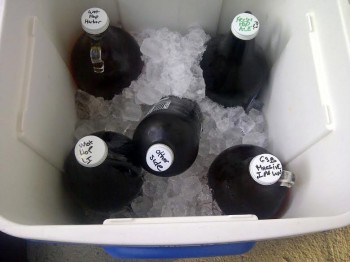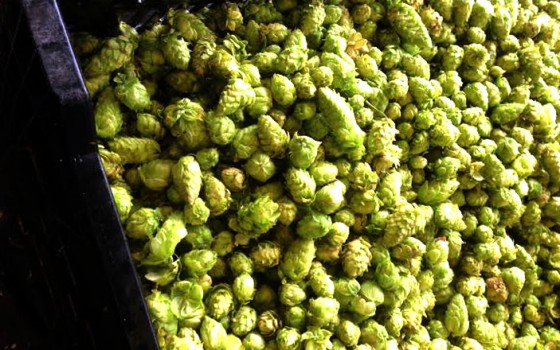Several months ago, Long Island was bombarded with an explosion of “wet hop” beers from our various local breweries. Lenn and I came up with this crazy idea to taste all of them and with a few emails and some miles on my car, we got all of them — except Southampton PublikHouse’s which was sold out.
What I found out went beyond just a mere tasting of beers. See, in tasting those beers I found that they weren’t living up to my expectations. Now, don’t get me wrong. There was nothing at all wrong with the beers we tasted. What we got were earthy, grassy, dank and forest-y pine notes with subtle hop bitterness. But I was left wanting something more. It just wasn’t what we expected.
So I left wondering what had happened. I mean I KNOW hops so I thought; was it the machine harvesting of the hops, were the breweries not ready for the hops (hops should be used within 24 hours of harvesting), was there something wrong with the hops, was it a bad year for hops, or was I looking for something that just was not there. Maybe I read too much into it the hype. Maybe it’s marketing.
 I sought out Greg Doroski — who just left Greenport Harbor Brewing to help open a new brew pub in Gowanus, Brooklyn — to help me work through some of my questions. He suggested that the bines will mature over the next few years and shift to that citrus note that I was looking for. He also added that the recipes need to be looked at. For example, Greenport’s Harbor Ale, based on a 30bbls (1 barrel is roughly 31 gallons of beer) uses 18 pounds of hop pellets. For the wet hop beer, 80 pounds of wet hops were used. They were all added at the end of the boil to maximize flavor and aroma. Greg did add one pound of pellet hops at the start for bitterness. (The longer the hops are in, the more bitter it becomes). Greg also considered the weight comparison of wet hops to pellet hops used in the recipe could be off a little.
I sought out Greg Doroski — who just left Greenport Harbor Brewing to help open a new brew pub in Gowanus, Brooklyn — to help me work through some of my questions. He suggested that the bines will mature over the next few years and shift to that citrus note that I was looking for. He also added that the recipes need to be looked at. For example, Greenport’s Harbor Ale, based on a 30bbls (1 barrel is roughly 31 gallons of beer) uses 18 pounds of hop pellets. For the wet hop beer, 80 pounds of wet hops were used. They were all added at the end of the boil to maximize flavor and aroma. Greg did add one pound of pellet hops at the start for bitterness. (The longer the hops are in, the more bitter it becomes). Greg also considered the weight comparison of wet hops to pellet hops used in the recipe could be off a little.
Compare that to Blue Point Brewing Company’s Wet Hop Experiment they used 200 pounds of fresh hops. That’s a huge difference.
I went and talked to Rick Sobotka, owner of Great South Bay Brewery via Facebook. For their Wet Hop Massive IPA, Great South Bay used only 20 pounds of fresh hops and added them to the boil at different intervals, 30 minutes left, 15 minutes left, five minutes then at one minute and lastly at flame out.
I knew I had to more research to really understand this “wet hop’ phenomenon which was and exploding on the east end of Long Island. This lead me to two key beers.
The first beer I was Sierra Nevada’s Northern Hemisphere Harvest Ale. This was the official first wet hop beer made in America in 1996 and has been made every year since. I tasted this beer twice, once in bottle and once from growler. This was an “a-ha” moment. It all came together quite quickly. It had all of the nuances of a harvest-like beer: dark, dank, and earthy. However, it also had a brightness that came from the fresh-picked hops — a subtle floral and citrus note, but a great bitter hops finish. And the malt came through and rounded out the bitter hops and left a clean, refreshing lengthy finish. No wonder why this is the one that some “fresh” or “wet” hop brewers look up to.
The second beere was Six Point Brewing’s Autumnation. Unlike the typical fall seasonal brews you find (like all the pumpkin beer) Six Point releases its fall seasonal to celebrate the season, the hop harvest season. And they turn to the fans to help make this beer.
The fans select from a number of different hops that Six Point lists. The 2013 Autumination is made with fresh picked Mosaic Hops. Where Six Point takes it up one more level than Sierra Nevada is turning to fellow hop heads to really bring the the beer and the hops season together.
That’s when it really hit me. I finally understood wet hop or fresh hop beers. You are not going to get to resiny ultra piney note from wet hop beers. That only comes when you dry the hops out. Think about it. Like cured meat, dried fruit, dried or botrytritus infected grapes. You can’t compare a trockenbeerenauslese to a standard riesling. You can’t compare Greenport’s Harbor Ale to their wet hop ale. They. Are. Two. Different. Animals.
So maybe on the East End there aren’t enough hops to go around for each brewery to get their hands on 200 pounds or more of fresh wet hops. But for what they get, to call them harvest ales in this young fresh hop culture could catch on. Most of the breweries that released wet hop beers, or as I will call them harvest beers, all released within a week or so of each other. Most were made with hops from Long Island. And all were drinkable, and now that I understand them, enjoyable.
Of the beers we tasted, I would pick Long Ireland Beer Company’s Wet Hop as my favorite by a nose, no pun intended. There was a bit more hop finish than the others. Port Jeff Brewing Company’s leaned a bit on the malty side with the hops poking around the sweet malt. Greenport Harbor’s was the most attractive and accessible. Not overly hoppy, for those afraid of hops, you would have no problem with this bottling.
The one we liked the most was probably the Great South Bay Massive IPA, but I can’t really can’t consider this the ‘best’ because it was the only IPA. It had the biggest starting hop profile and most floral of all. But the “base” beer was already an IPA, unlike the others.
Ultimately, I think these beers would be better branded as “harvest ales” than emphasizing hops in the name. That shifts expectations where they belong.


